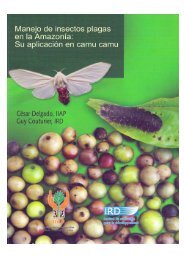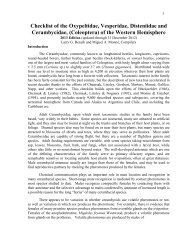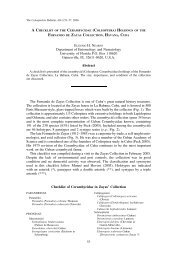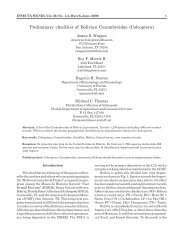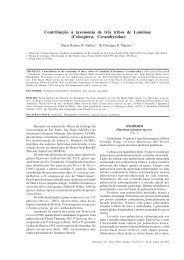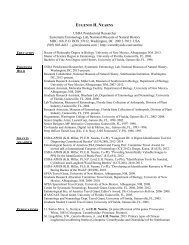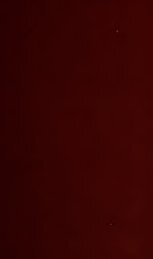Create successful ePaper yourself
Turn your PDF publications into a flip-book with our unique Google optimized e-Paper software.
LAWRENCE S. DILLON <strong>AND</strong> ELIZABETH S. DILLON 13<br />
sides moderately attenuate, apices separately rounded; basal gibbosities moderately<br />
elevated; disk on basal third finely granulate-Ilunctate or simply punctate; humeri<br />
variable, simply projecting or crested. Prosrernwn simple, widened posteriorly;<br />
mesosterna! process broad, short, sides nearly straight, apex deeply emarginate.<br />
Legs moderate in length; proeoxae globose, strongly uncate in male, not (or<br />
very feebly) tuberculate in femnle; femora clavate apically; meta tibiae not<br />
expanded ; protarsi dilated in male, slightly so in female. Antennae one and one<br />
half to one and two-thirds times as long as body in male, at least as long as<br />
body in female; scape short, reaching only to apical fourth of pronotum, strongly<br />
clavate from base; third segment bi.sinuous, one-half longer than scape in male,<br />
one-fourth longer in female; rest gradually shorter. eleventh slightly longer than<br />
tenth in male, in female rest much shortened from fourth.<br />
GENOTYPE : Lamia acromii Dalman.<br />
KEY TO SPECIES<br />
Humeri crested; antennae with bllsal two-thirds of all segments from third testaooous;<br />
tarsal claw segments at base testaceQU3 . . . . . . ... . . . . . ........ aeromii.<br />
Humeri projecting but uncrested; antennae with basal t·wo-third! of segments from<br />
third reddish-brown; tarsal claw segments basally reddish-brown ..... cari88ima.<br />
Lesbates aeromii Dalman<br />
PLATt: III, FICURE 13.<br />
Lamia acromu Dalman, Analecta Ent., 1823, p. 70.<br />
Hyptioma acromii Dalman. Aurivillius, Cat. Coleoptorum, pars 74, 1923, p. 343.<br />
Hyptioma omoplata Lacordaire, Gen. Col., IX, 1872, p. 676, note 1, pI. 104, fig. 5.<br />
:MALE. Elongate-ovate, robust, convex; reddish-brown or dark reddish-brown,<br />
densely covered with gray-fulvous pubescence, somewhat mottled with brown, and<br />
marked with white as follows: Head with occiput irregularly white, front almost<br />
completely so, as is entire head occasionally. Pronotum white laterally, medially,<br />
and along base, sometimes with the fuivous very strongly reduced' or wanting.<br />
Scutellum more or less broadly margined with white. Elytra 'more or less white at<br />
base, around scutellum, and along suture, with a broad, oblique, somewhat inter<br />
rupted fascia at middle. Body beneath dark reddish-brown to fuscous, entirely<br />
covered with dense, white pubescence, except at middle of last three abdominal<br />
starnites, which a.re only thinly pubescent, apex of fifth brown. Legs reddish<br />
brown to dark reddish-brown, thinly white pubescent; tarsi with claw segment<br />
pale rosy on basal half. Antennae pale rosy, scape and apical third of each<br />
segment fuscous; entirely covered with thin whitish pubescence, except OIl dark<br />
apices, where it is brown pubescent; scape with a broad, brownish band around<br />
the broadest portion before apex.<br />
Head minutely, densely punctate, with a fine median line from occiput to epistomn;<br />
front ciongate, broad, narrowed feebly below eyes, finely, densely punctate; genae<br />
very elongate, vertical, finely and densely punctate, with a few coarse punctures<br />
interspersed; eye with lower lobe small, subquadr!1te, only slightly longer than



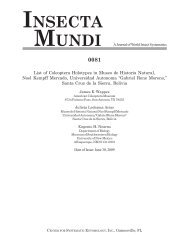
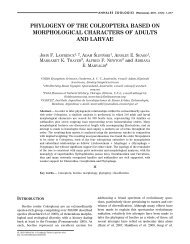


![Coleoptera. Vol. I. [Longicornia. Part I.]](https://img.yumpu.com/41202793/1/180x260/coleoptera-vol-i-longicornia-part-i.jpg?quality=85)
